Challenges and Approaches in Social Work with Indigenous Australians
VerifiedAdded on 2022/10/04
|14
|3074
|36
Report
AI Summary
This report provides a comprehensive overview of social work practice in the context of Aboriginal and Torres Strait Islander communities in Australia. It begins by outlining the historical background, including the impact of colonialism and government policies on Indigenous peoples, highlighting key issues such as political oppression, economic instability, and social racism. The report then delves into the major theories underpinning social work in this field, including Whiteness theory and Human Rights practices, emphasizing the importance of cultural sensitivity and anti-racist approaches. It also examines current policies and practices, such as the 'Closing the Gap' initiative and the 'Native Title' law, while assessing their impact. The report stresses the role of social workers in advocating for human rights, promoting social justice, and addressing the unique challenges faced by Indigenous communities. It also highlights the importance of understanding the historical context, political landscape, and cultural nuances to provide effective and culturally responsive services. The report concludes by underscoring the need for ongoing efforts to improve the well-being and social outcomes of Aboriginal and Torres Strait Islander peoples.
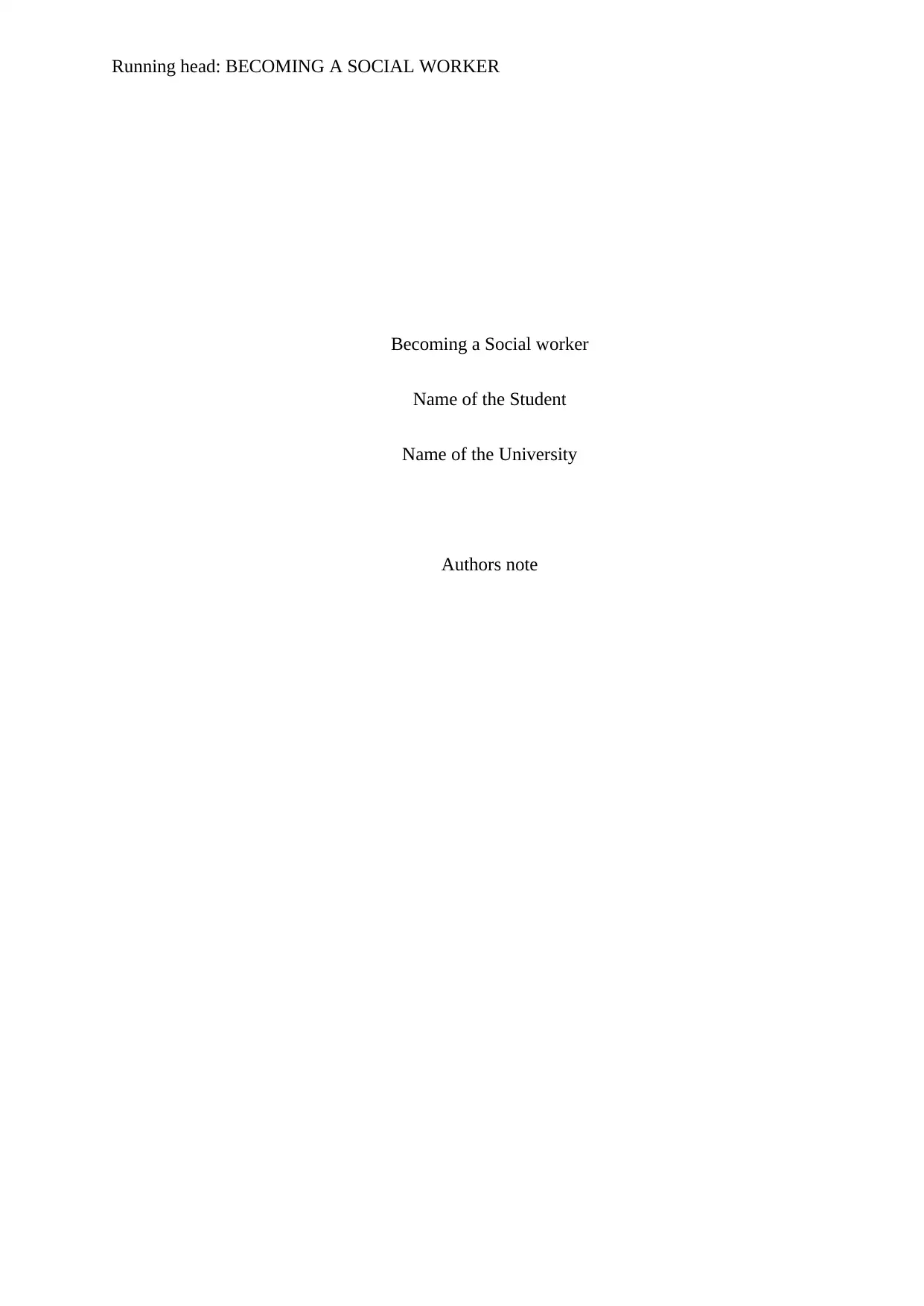
Running head: BECOMING A SOCIAL WORKER
Becoming a Social worker
Name of the Student
Name of the University
Authors note
Becoming a Social worker
Name of the Student
Name of the University
Authors note
Paraphrase This Document
Need a fresh take? Get an instant paraphrase of this document with our AI Paraphraser
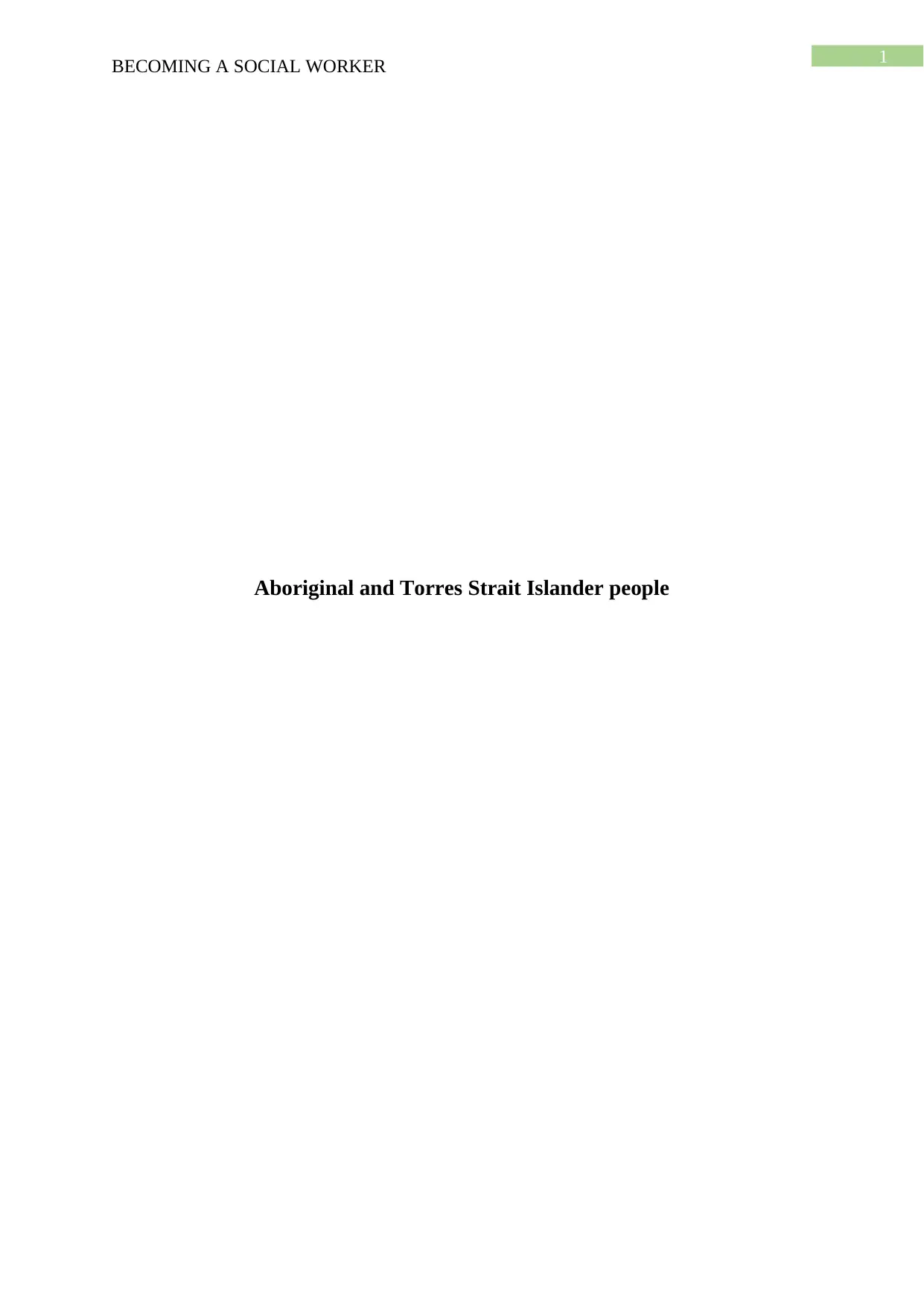
1
BECOMING A SOCIAL WORKER
Aboriginal and Torres Strait Islander people
BECOMING A SOCIAL WORKER
Aboriginal and Torres Strait Islander people
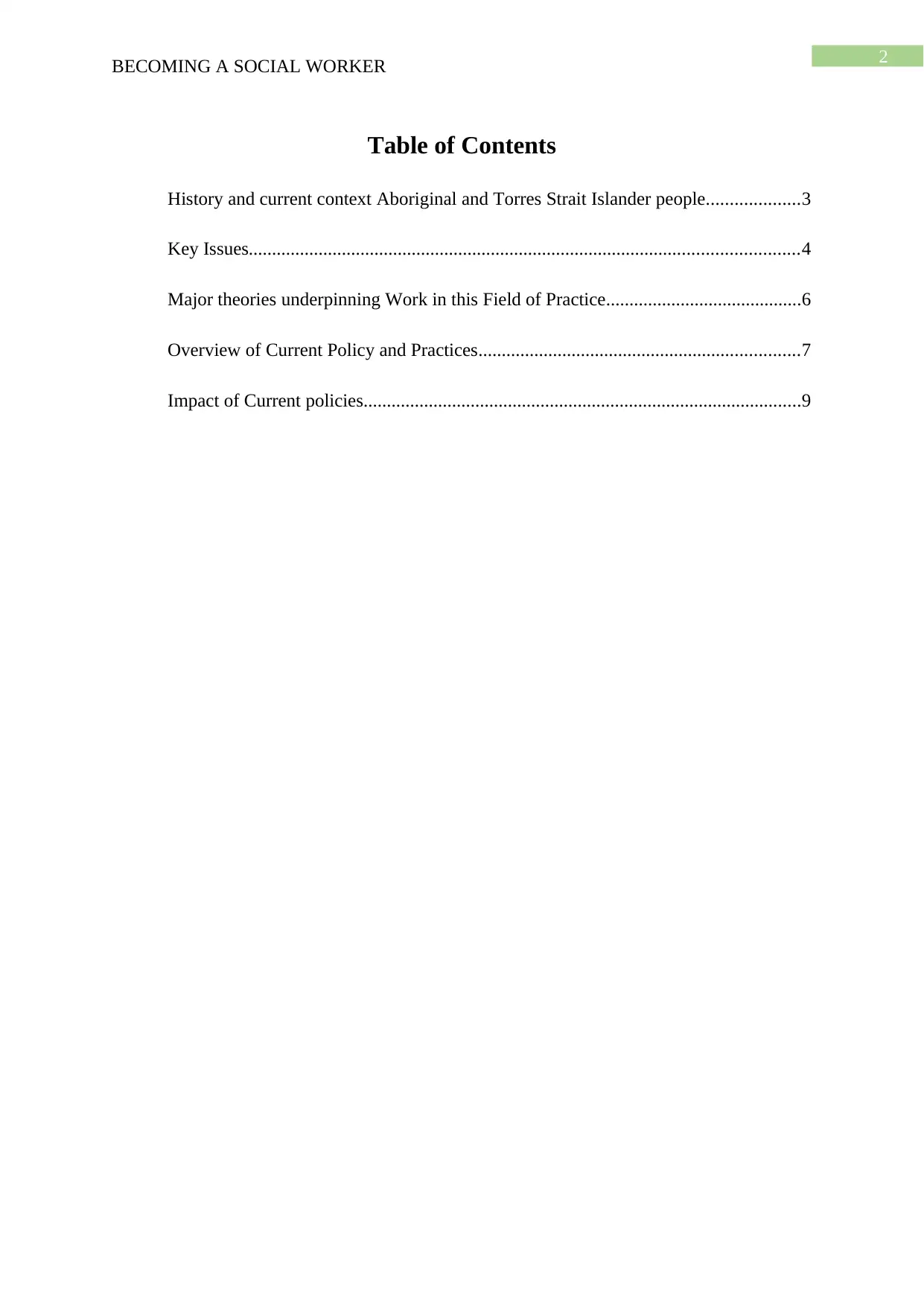
2
BECOMING A SOCIAL WORKER
Table of Contents
History and current context Aboriginal and Torres Strait Islander people....................3
Key Issues......................................................................................................................4
Major theories underpinning Work in this Field of Practice..........................................6
Overview of Current Policy and Practices.....................................................................7
Impact of Current policies..............................................................................................9
BECOMING A SOCIAL WORKER
Table of Contents
History and current context Aboriginal and Torres Strait Islander people....................3
Key Issues......................................................................................................................4
Major theories underpinning Work in this Field of Practice..........................................6
Overview of Current Policy and Practices.....................................................................7
Impact of Current policies..............................................................................................9
⊘ This is a preview!⊘
Do you want full access?
Subscribe today to unlock all pages.

Trusted by 1+ million students worldwide
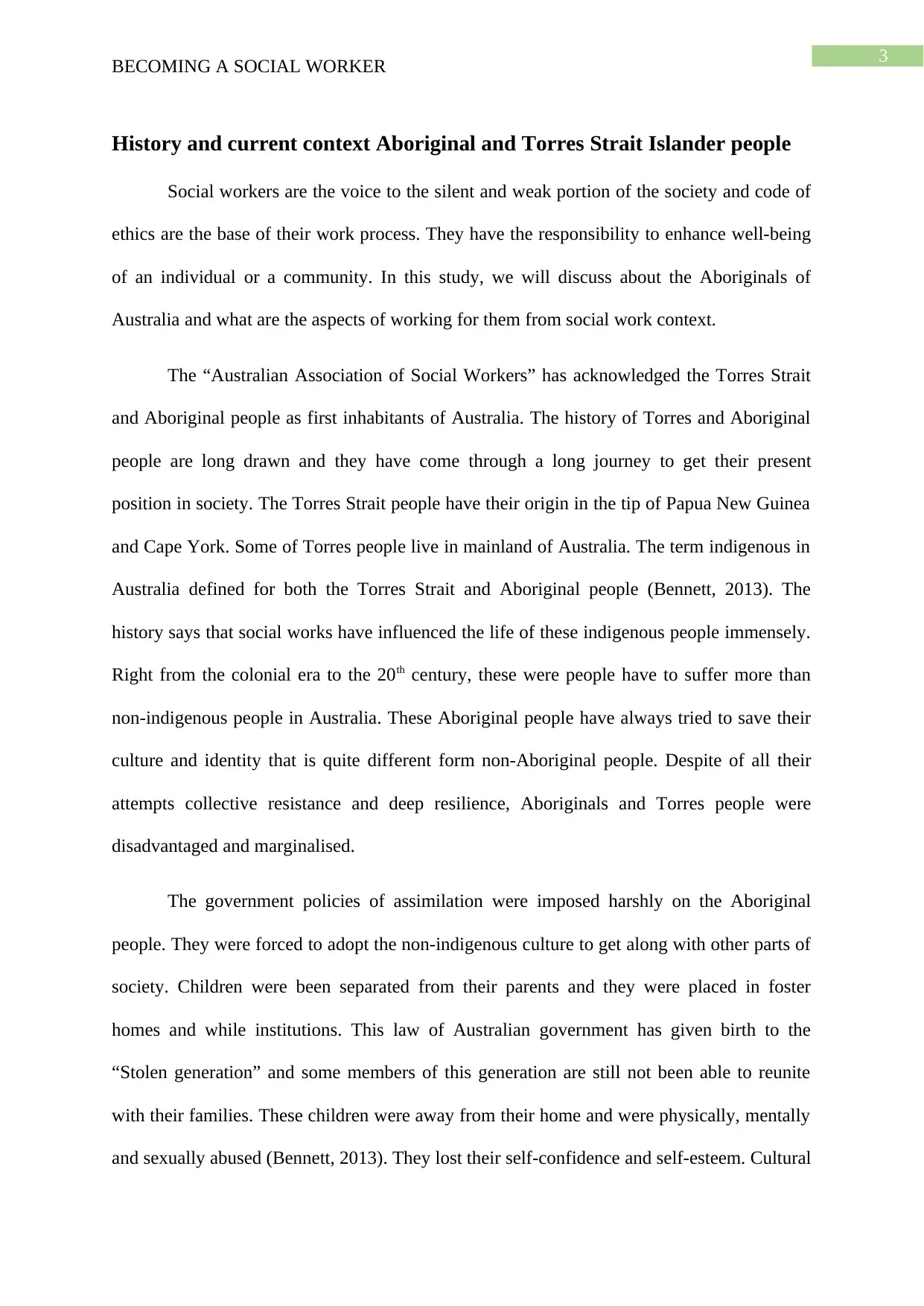
3
BECOMING A SOCIAL WORKER
History and current context Aboriginal and Torres Strait Islander people
Social workers are the voice to the silent and weak portion of the society and code of
ethics are the base of their work process. They have the responsibility to enhance well-being
of an individual or a community. In this study, we will discuss about the Aboriginals of
Australia and what are the aspects of working for them from social work context.
The “Australian Association of Social Workers” has acknowledged the Torres Strait
and Aboriginal people as first inhabitants of Australia. The history of Torres and Aboriginal
people are long drawn and they have come through a long journey to get their present
position in society. The Torres Strait people have their origin in the tip of Papua New Guinea
and Cape York. Some of Torres people live in mainland of Australia. The term indigenous in
Australia defined for both the Torres Strait and Aboriginal people (Bennett, 2013). The
history says that social works have influenced the life of these indigenous people immensely.
Right from the colonial era to the 20th century, these were people have to suffer more than
non-indigenous people in Australia. These Aboriginal people have always tried to save their
culture and identity that is quite different form non-Aboriginal people. Despite of all their
attempts collective resistance and deep resilience, Aboriginals and Torres people were
disadvantaged and marginalised.
The government policies of assimilation were imposed harshly on the Aboriginal
people. They were forced to adopt the non-indigenous culture to get along with other parts of
society. Children were been separated from their parents and they were placed in foster
homes and while institutions. This law of Australian government has given birth to the
“Stolen generation” and some members of this generation are still not been able to reunite
with their families. These children were away from their home and were physically, mentally
and sexually abused (Bennett, 2013). They lost their self-confidence and self-esteem. Cultural
BECOMING A SOCIAL WORKER
History and current context Aboriginal and Torres Strait Islander people
Social workers are the voice to the silent and weak portion of the society and code of
ethics are the base of their work process. They have the responsibility to enhance well-being
of an individual or a community. In this study, we will discuss about the Aboriginals of
Australia and what are the aspects of working for them from social work context.
The “Australian Association of Social Workers” has acknowledged the Torres Strait
and Aboriginal people as first inhabitants of Australia. The history of Torres and Aboriginal
people are long drawn and they have come through a long journey to get their present
position in society. The Torres Strait people have their origin in the tip of Papua New Guinea
and Cape York. Some of Torres people live in mainland of Australia. The term indigenous in
Australia defined for both the Torres Strait and Aboriginal people (Bennett, 2013). The
history says that social works have influenced the life of these indigenous people immensely.
Right from the colonial era to the 20th century, these were people have to suffer more than
non-indigenous people in Australia. These Aboriginal people have always tried to save their
culture and identity that is quite different form non-Aboriginal people. Despite of all their
attempts collective resistance and deep resilience, Aboriginals and Torres people were
disadvantaged and marginalised.
The government policies of assimilation were imposed harshly on the Aboriginal
people. They were forced to adopt the non-indigenous culture to get along with other parts of
society. Children were been separated from their parents and they were placed in foster
homes and while institutions. This law of Australian government has given birth to the
“Stolen generation” and some members of this generation are still not been able to reunite
with their families. These children were away from their home and were physically, mentally
and sexually abused (Bennett, 2013). They lost their self-confidence and self-esteem. Cultural
Paraphrase This Document
Need a fresh take? Get an instant paraphrase of this document with our AI Paraphraser
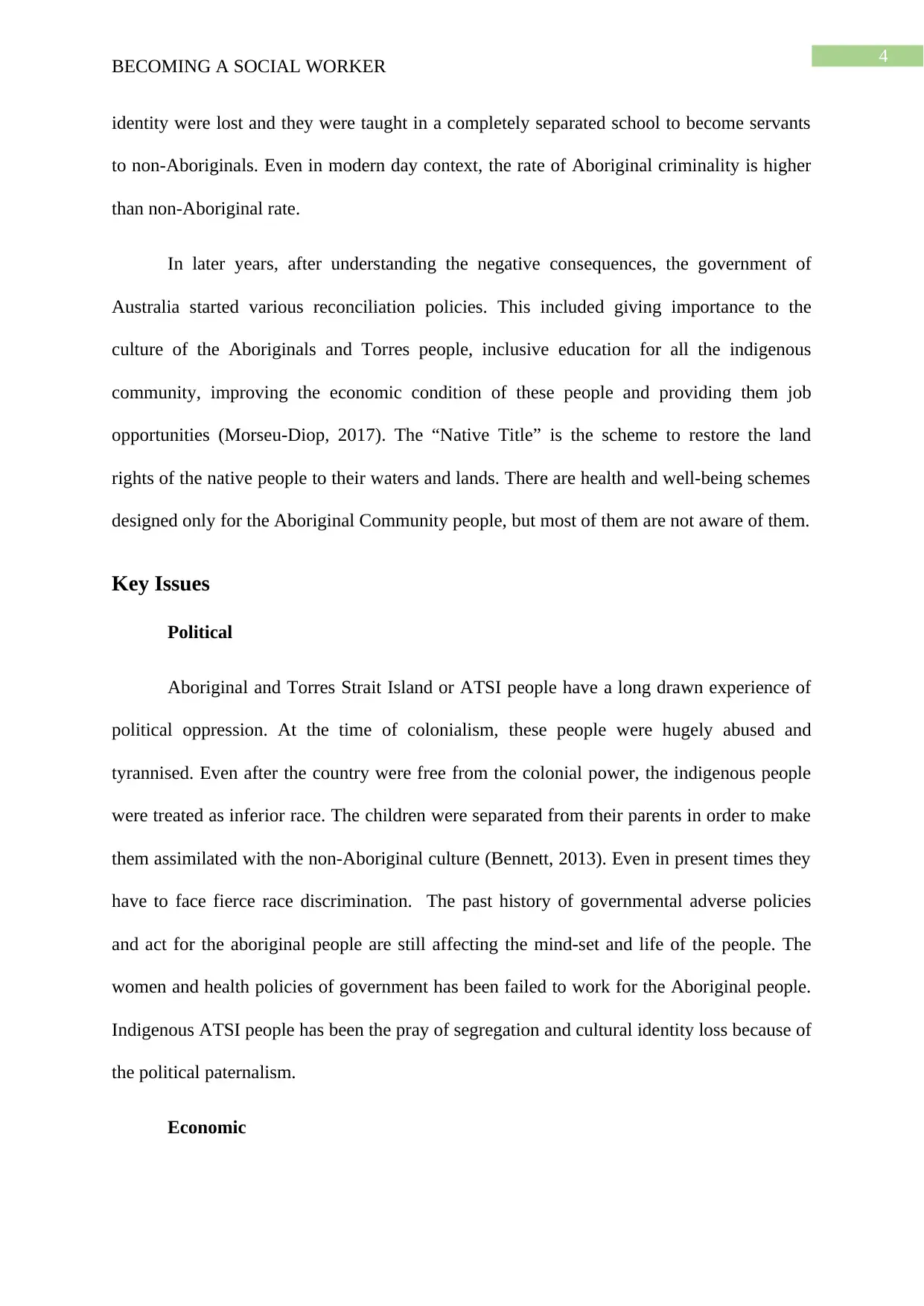
4
BECOMING A SOCIAL WORKER
identity were lost and they were taught in a completely separated school to become servants
to non-Aboriginals. Even in modern day context, the rate of Aboriginal criminality is higher
than non-Aboriginal rate.
In later years, after understanding the negative consequences, the government of
Australia started various reconciliation policies. This included giving importance to the
culture of the Aboriginals and Torres people, inclusive education for all the indigenous
community, improving the economic condition of these people and providing them job
opportunities (Morseu-Diop, 2017). The “Native Title” is the scheme to restore the land
rights of the native people to their waters and lands. There are health and well-being schemes
designed only for the Aboriginal Community people, but most of them are not aware of them.
Key Issues
Political
Aboriginal and Torres Strait Island or ATSI people have a long drawn experience of
political oppression. At the time of colonialism, these people were hugely abused and
tyrannised. Even after the country were free from the colonial power, the indigenous people
were treated as inferior race. The children were separated from their parents in order to make
them assimilated with the non-Aboriginal culture (Bennett, 2013). Even in present times they
have to face fierce race discrimination. The past history of governmental adverse policies
and act for the aboriginal people are still affecting the mind-set and life of the people. The
women and health policies of government has been failed to work for the Aboriginal people.
Indigenous ATSI people has been the pray of segregation and cultural identity loss because of
the political paternalism.
Economic
BECOMING A SOCIAL WORKER
identity were lost and they were taught in a completely separated school to become servants
to non-Aboriginals. Even in modern day context, the rate of Aboriginal criminality is higher
than non-Aboriginal rate.
In later years, after understanding the negative consequences, the government of
Australia started various reconciliation policies. This included giving importance to the
culture of the Aboriginals and Torres people, inclusive education for all the indigenous
community, improving the economic condition of these people and providing them job
opportunities (Morseu-Diop, 2017). The “Native Title” is the scheme to restore the land
rights of the native people to their waters and lands. There are health and well-being schemes
designed only for the Aboriginal Community people, but most of them are not aware of them.
Key Issues
Political
Aboriginal and Torres Strait Island or ATSI people have a long drawn experience of
political oppression. At the time of colonialism, these people were hugely abused and
tyrannised. Even after the country were free from the colonial power, the indigenous people
were treated as inferior race. The children were separated from their parents in order to make
them assimilated with the non-Aboriginal culture (Bennett, 2013). Even in present times they
have to face fierce race discrimination. The past history of governmental adverse policies
and act for the aboriginal people are still affecting the mind-set and life of the people. The
women and health policies of government has been failed to work for the Aboriginal people.
Indigenous ATSI people has been the pray of segregation and cultural identity loss because of
the political paternalism.
Economic
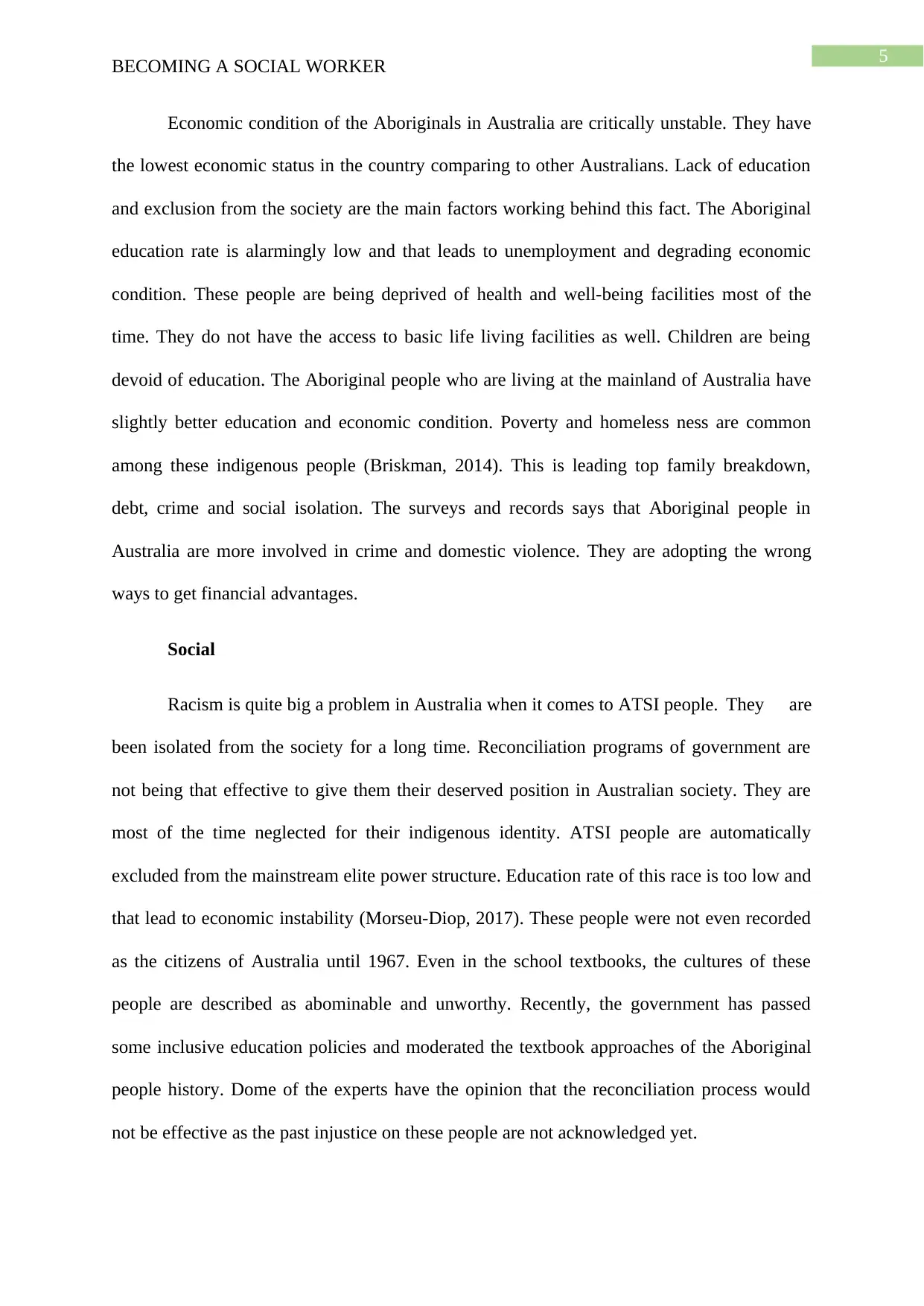
5
BECOMING A SOCIAL WORKER
Economic condition of the Aboriginals in Australia are critically unstable. They have
the lowest economic status in the country comparing to other Australians. Lack of education
and exclusion from the society are the main factors working behind this fact. The Aboriginal
education rate is alarmingly low and that leads to unemployment and degrading economic
condition. These people are being deprived of health and well-being facilities most of the
time. They do not have the access to basic life living facilities as well. Children are being
devoid of education. The Aboriginal people who are living at the mainland of Australia have
slightly better education and economic condition. Poverty and homeless ness are common
among these indigenous people (Briskman, 2014). This is leading top family breakdown,
debt, crime and social isolation. The surveys and records says that Aboriginal people in
Australia are more involved in crime and domestic violence. They are adopting the wrong
ways to get financial advantages.
Social
Racism is quite big a problem in Australia when it comes to ATSI people. They are
been isolated from the society for a long time. Reconciliation programs of government are
not being that effective to give them their deserved position in Australian society. They are
most of the time neglected for their indigenous identity. ATSI people are automatically
excluded from the mainstream elite power structure. Education rate of this race is too low and
that lead to economic instability (Morseu-Diop, 2017). These people were not even recorded
as the citizens of Australia until 1967. Even in the school textbooks, the cultures of these
people are described as abominable and unworthy. Recently, the government has passed
some inclusive education policies and moderated the textbook approaches of the Aboriginal
people history. Dome of the experts have the opinion that the reconciliation process would
not be effective as the past injustice on these people are not acknowledged yet.
BECOMING A SOCIAL WORKER
Economic condition of the Aboriginals in Australia are critically unstable. They have
the lowest economic status in the country comparing to other Australians. Lack of education
and exclusion from the society are the main factors working behind this fact. The Aboriginal
education rate is alarmingly low and that leads to unemployment and degrading economic
condition. These people are being deprived of health and well-being facilities most of the
time. They do not have the access to basic life living facilities as well. Children are being
devoid of education. The Aboriginal people who are living at the mainland of Australia have
slightly better education and economic condition. Poverty and homeless ness are common
among these indigenous people (Briskman, 2014). This is leading top family breakdown,
debt, crime and social isolation. The surveys and records says that Aboriginal people in
Australia are more involved in crime and domestic violence. They are adopting the wrong
ways to get financial advantages.
Social
Racism is quite big a problem in Australia when it comes to ATSI people. They are
been isolated from the society for a long time. Reconciliation programs of government are
not being that effective to give them their deserved position in Australian society. They are
most of the time neglected for their indigenous identity. ATSI people are automatically
excluded from the mainstream elite power structure. Education rate of this race is too low and
that lead to economic instability (Morseu-Diop, 2017). These people were not even recorded
as the citizens of Australia until 1967. Even in the school textbooks, the cultures of these
people are described as abominable and unworthy. Recently, the government has passed
some inclusive education policies and moderated the textbook approaches of the Aboriginal
people history. Dome of the experts have the opinion that the reconciliation process would
not be effective as the past injustice on these people are not acknowledged yet.
⊘ This is a preview!⊘
Do you want full access?
Subscribe today to unlock all pages.

Trusted by 1+ million students worldwide
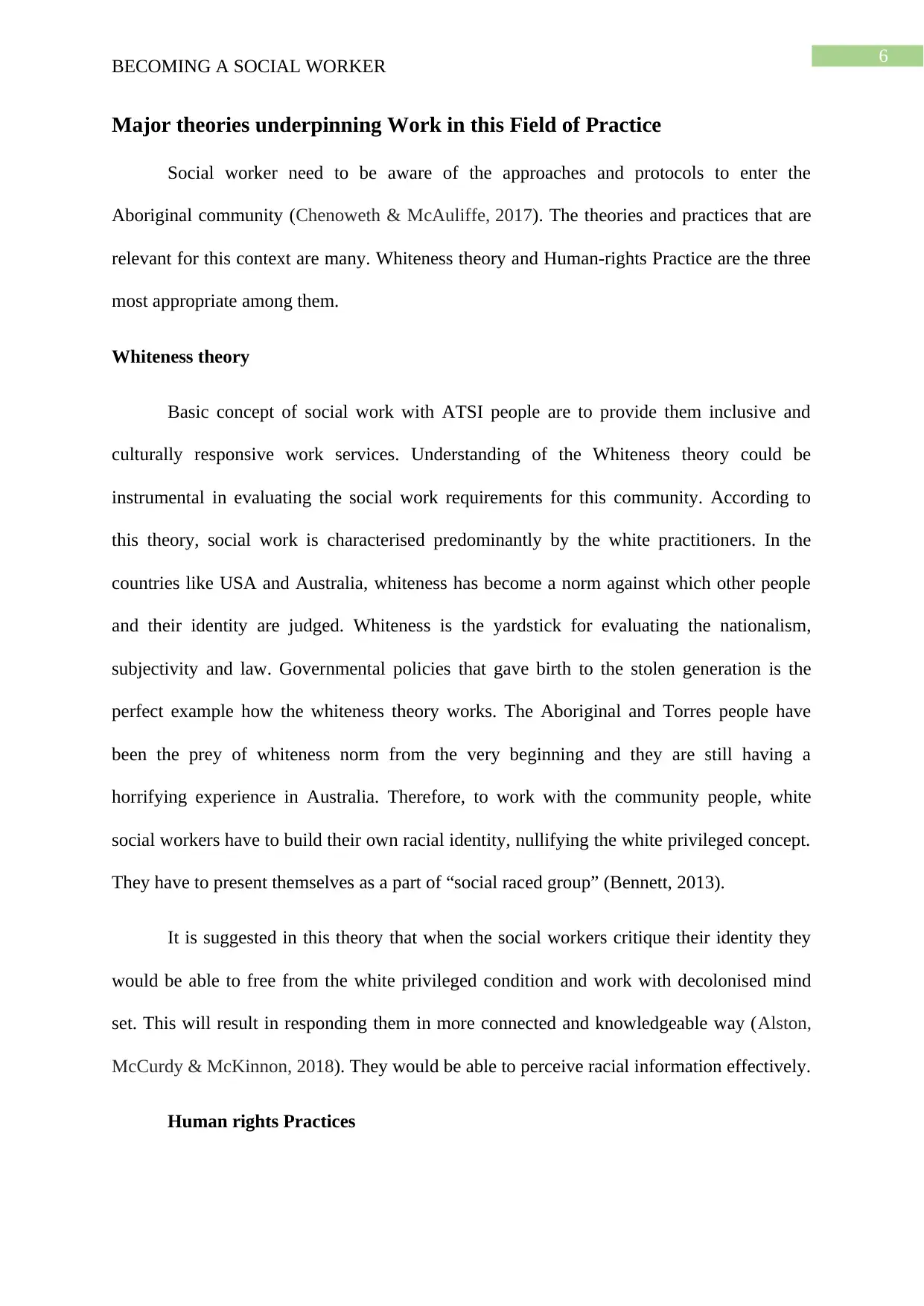
6
BECOMING A SOCIAL WORKER
Major theories underpinning Work in this Field of Practice
Social worker need to be aware of the approaches and protocols to enter the
Aboriginal community (Chenoweth & McAuliffe, 2017). The theories and practices that are
relevant for this context are many. Whiteness theory and Human-rights Practice are the three
most appropriate among them.
Whiteness theory
Basic concept of social work with ATSI people are to provide them inclusive and
culturally responsive work services. Understanding of the Whiteness theory could be
instrumental in evaluating the social work requirements for this community. According to
this theory, social work is characterised predominantly by the white practitioners. In the
countries like USA and Australia, whiteness has become a norm against which other people
and their identity are judged. Whiteness is the yardstick for evaluating the nationalism,
subjectivity and law. Governmental policies that gave birth to the stolen generation is the
perfect example how the whiteness theory works. The Aboriginal and Torres people have
been the prey of whiteness norm from the very beginning and they are still having a
horrifying experience in Australia. Therefore, to work with the community people, white
social workers have to build their own racial identity, nullifying the white privileged concept.
They have to present themselves as a part of “social raced group” (Bennett, 2013).
It is suggested in this theory that when the social workers critique their identity they
would be able to free from the white privileged condition and work with decolonised mind
set. This will result in responding them in more connected and knowledgeable way (Alston,
McCurdy & McKinnon, 2018). They would be able to perceive racial information effectively.
Human rights Practices
BECOMING A SOCIAL WORKER
Major theories underpinning Work in this Field of Practice
Social worker need to be aware of the approaches and protocols to enter the
Aboriginal community (Chenoweth & McAuliffe, 2017). The theories and practices that are
relevant for this context are many. Whiteness theory and Human-rights Practice are the three
most appropriate among them.
Whiteness theory
Basic concept of social work with ATSI people are to provide them inclusive and
culturally responsive work services. Understanding of the Whiteness theory could be
instrumental in evaluating the social work requirements for this community. According to
this theory, social work is characterised predominantly by the white practitioners. In the
countries like USA and Australia, whiteness has become a norm against which other people
and their identity are judged. Whiteness is the yardstick for evaluating the nationalism,
subjectivity and law. Governmental policies that gave birth to the stolen generation is the
perfect example how the whiteness theory works. The Aboriginal and Torres people have
been the prey of whiteness norm from the very beginning and they are still having a
horrifying experience in Australia. Therefore, to work with the community people, white
social workers have to build their own racial identity, nullifying the white privileged concept.
They have to present themselves as a part of “social raced group” (Bennett, 2013).
It is suggested in this theory that when the social workers critique their identity they
would be able to free from the white privileged condition and work with decolonised mind
set. This will result in responding them in more connected and knowledgeable way (Alston,
McCurdy & McKinnon, 2018). They would be able to perceive racial information effectively.
Human rights Practices
Paraphrase This Document
Need a fresh take? Get an instant paraphrase of this document with our AI Paraphraser
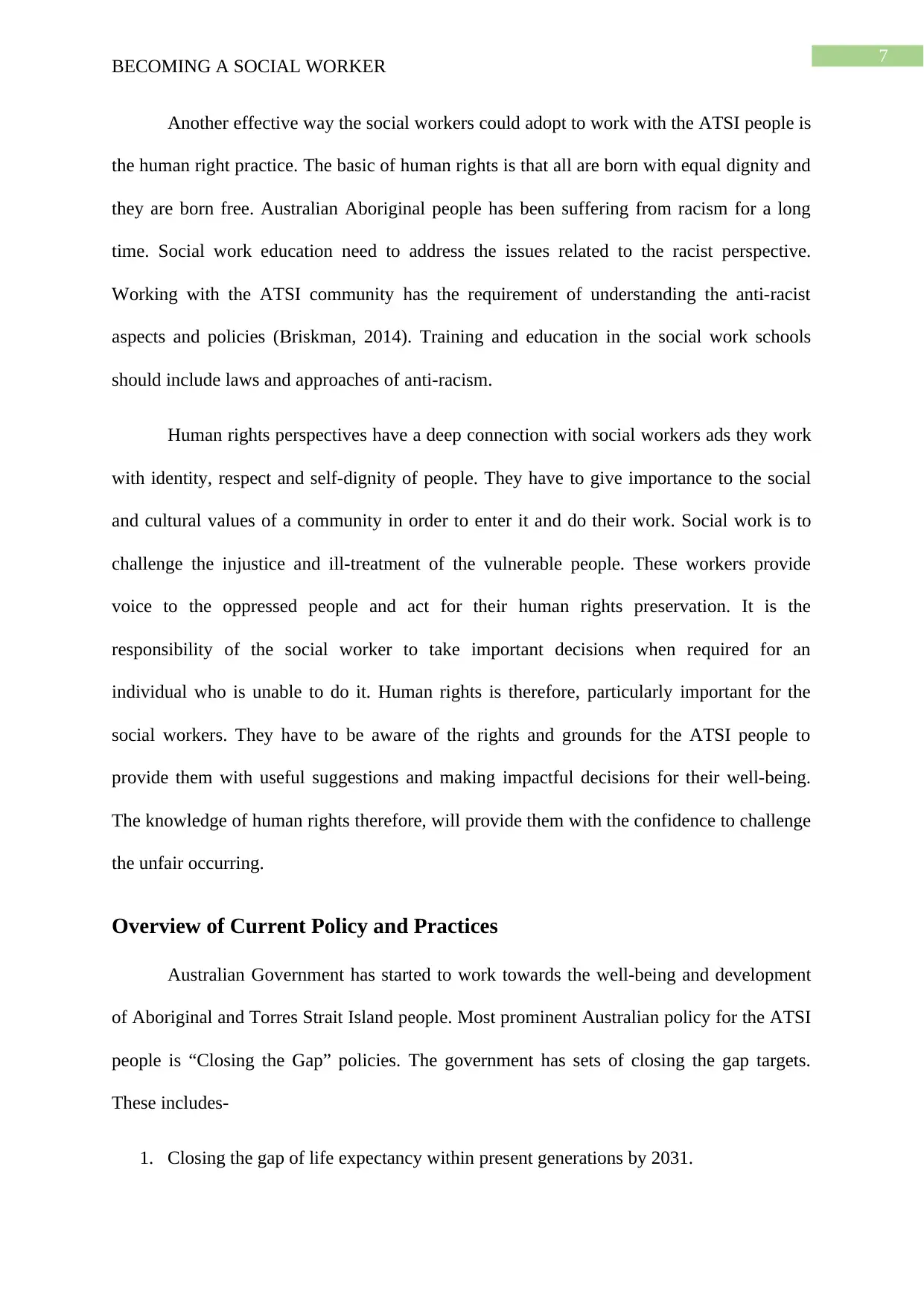
7
BECOMING A SOCIAL WORKER
Another effective way the social workers could adopt to work with the ATSI people is
the human right practice. The basic of human rights is that all are born with equal dignity and
they are born free. Australian Aboriginal people has been suffering from racism for a long
time. Social work education need to address the issues related to the racist perspective.
Working with the ATSI community has the requirement of understanding the anti-racist
aspects and policies (Briskman, 2014). Training and education in the social work schools
should include laws and approaches of anti-racism.
Human rights perspectives have a deep connection with social workers ads they work
with identity, respect and self-dignity of people. They have to give importance to the social
and cultural values of a community in order to enter it and do their work. Social work is to
challenge the injustice and ill-treatment of the vulnerable people. These workers provide
voice to the oppressed people and act for their human rights preservation. It is the
responsibility of the social worker to take important decisions when required for an
individual who is unable to do it. Human rights is therefore, particularly important for the
social workers. They have to be aware of the rights and grounds for the ATSI people to
provide them with useful suggestions and making impactful decisions for their well-being.
The knowledge of human rights therefore, will provide them with the confidence to challenge
the unfair occurring.
Overview of Current Policy and Practices
Australian Government has started to work towards the well-being and development
of Aboriginal and Torres Strait Island people. Most prominent Australian policy for the ATSI
people is “Closing the Gap” policies. The government has sets of closing the gap targets.
These includes-
1. Closing the gap of life expectancy within present generations by 2031.
BECOMING A SOCIAL WORKER
Another effective way the social workers could adopt to work with the ATSI people is
the human right practice. The basic of human rights is that all are born with equal dignity and
they are born free. Australian Aboriginal people has been suffering from racism for a long
time. Social work education need to address the issues related to the racist perspective.
Working with the ATSI community has the requirement of understanding the anti-racist
aspects and policies (Briskman, 2014). Training and education in the social work schools
should include laws and approaches of anti-racism.
Human rights perspectives have a deep connection with social workers ads they work
with identity, respect and self-dignity of people. They have to give importance to the social
and cultural values of a community in order to enter it and do their work. Social work is to
challenge the injustice and ill-treatment of the vulnerable people. These workers provide
voice to the oppressed people and act for their human rights preservation. It is the
responsibility of the social worker to take important decisions when required for an
individual who is unable to do it. Human rights is therefore, particularly important for the
social workers. They have to be aware of the rights and grounds for the ATSI people to
provide them with useful suggestions and making impactful decisions for their well-being.
The knowledge of human rights therefore, will provide them with the confidence to challenge
the unfair occurring.
Overview of Current Policy and Practices
Australian Government has started to work towards the well-being and development
of Aboriginal and Torres Strait Island people. Most prominent Australian policy for the ATSI
people is “Closing the Gap” policies. The government has sets of closing the gap targets.
These includes-
1. Closing the gap of life expectancy within present generations by 2031.
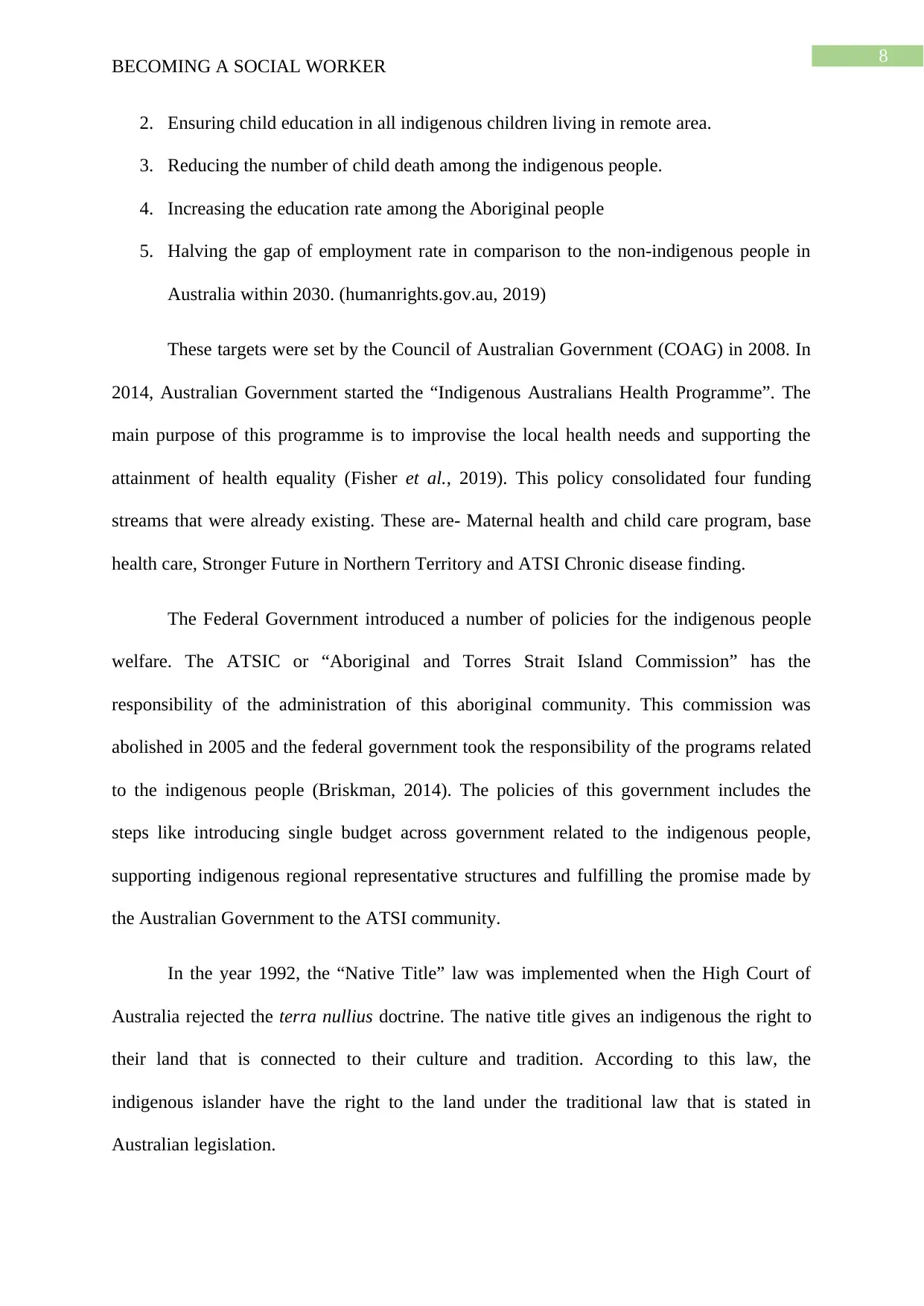
8
BECOMING A SOCIAL WORKER
2. Ensuring child education in all indigenous children living in remote area.
3. Reducing the number of child death among the indigenous people.
4. Increasing the education rate among the Aboriginal people
5. Halving the gap of employment rate in comparison to the non-indigenous people in
Australia within 2030. (humanrights.gov.au, 2019)
These targets were set by the Council of Australian Government (COAG) in 2008. In
2014, Australian Government started the “Indigenous Australians Health Programme”. The
main purpose of this programme is to improvise the local health needs and supporting the
attainment of health equality (Fisher et al., 2019). This policy consolidated four funding
streams that were already existing. These are- Maternal health and child care program, base
health care, Stronger Future in Northern Territory and ATSI Chronic disease finding.
The Federal Government introduced a number of policies for the indigenous people
welfare. The ATSIC or “Aboriginal and Torres Strait Island Commission” has the
responsibility of the administration of this aboriginal community. This commission was
abolished in 2005 and the federal government took the responsibility of the programs related
to the indigenous people (Briskman, 2014). The policies of this government includes the
steps like introducing single budget across government related to the indigenous people,
supporting indigenous regional representative structures and fulfilling the promise made by
the Australian Government to the ATSI community.
In the year 1992, the “Native Title” law was implemented when the High Court of
Australia rejected the terra nullius doctrine. The native title gives an indigenous the right to
their land that is connected to their culture and tradition. According to this law, the
indigenous islander have the right to the land under the traditional law that is stated in
Australian legislation.
BECOMING A SOCIAL WORKER
2. Ensuring child education in all indigenous children living in remote area.
3. Reducing the number of child death among the indigenous people.
4. Increasing the education rate among the Aboriginal people
5. Halving the gap of employment rate in comparison to the non-indigenous people in
Australia within 2030. (humanrights.gov.au, 2019)
These targets were set by the Council of Australian Government (COAG) in 2008. In
2014, Australian Government started the “Indigenous Australians Health Programme”. The
main purpose of this programme is to improvise the local health needs and supporting the
attainment of health equality (Fisher et al., 2019). This policy consolidated four funding
streams that were already existing. These are- Maternal health and child care program, base
health care, Stronger Future in Northern Territory and ATSI Chronic disease finding.
The Federal Government introduced a number of policies for the indigenous people
welfare. The ATSIC or “Aboriginal and Torres Strait Island Commission” has the
responsibility of the administration of this aboriginal community. This commission was
abolished in 2005 and the federal government took the responsibility of the programs related
to the indigenous people (Briskman, 2014). The policies of this government includes the
steps like introducing single budget across government related to the indigenous people,
supporting indigenous regional representative structures and fulfilling the promise made by
the Australian Government to the ATSI community.
In the year 1992, the “Native Title” law was implemented when the High Court of
Australia rejected the terra nullius doctrine. The native title gives an indigenous the right to
their land that is connected to their culture and tradition. According to this law, the
indigenous islander have the right to the land under the traditional law that is stated in
Australian legislation.
⊘ This is a preview!⊘
Do you want full access?
Subscribe today to unlock all pages.

Trusted by 1+ million students worldwide
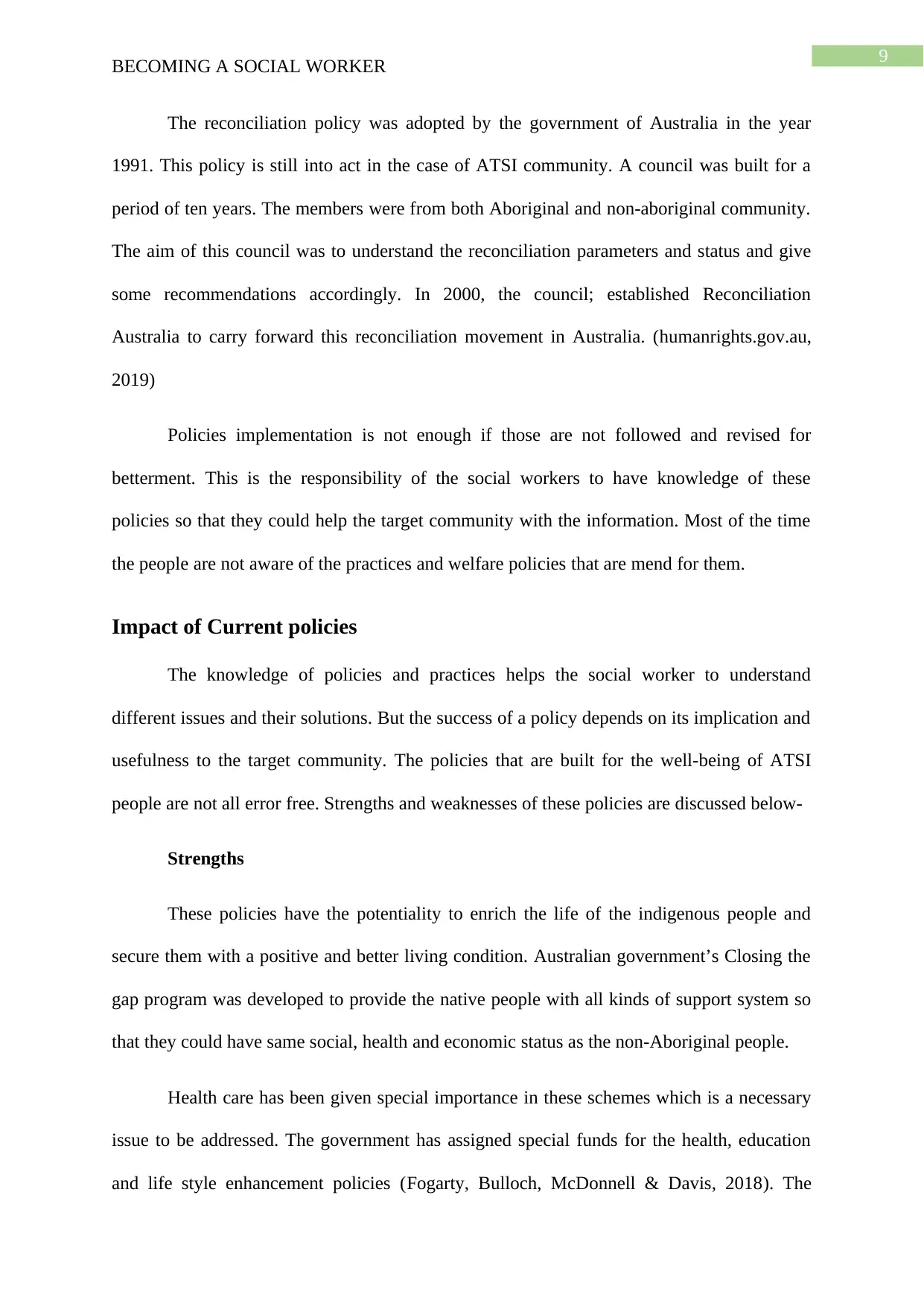
9
BECOMING A SOCIAL WORKER
The reconciliation policy was adopted by the government of Australia in the year
1991. This policy is still into act in the case of ATSI community. A council was built for a
period of ten years. The members were from both Aboriginal and non-aboriginal community.
The aim of this council was to understand the reconciliation parameters and status and give
some recommendations accordingly. In 2000, the council; established Reconciliation
Australia to carry forward this reconciliation movement in Australia. (humanrights.gov.au,
2019)
Policies implementation is not enough if those are not followed and revised for
betterment. This is the responsibility of the social workers to have knowledge of these
policies so that they could help the target community with the information. Most of the time
the people are not aware of the practices and welfare policies that are mend for them.
Impact of Current policies
The knowledge of policies and practices helps the social worker to understand
different issues and their solutions. But the success of a policy depends on its implication and
usefulness to the target community. The policies that are built for the well-being of ATSI
people are not all error free. Strengths and weaknesses of these policies are discussed below-
Strengths
These policies have the potentiality to enrich the life of the indigenous people and
secure them with a positive and better living condition. Australian government’s Closing the
gap program was developed to provide the native people with all kinds of support system so
that they could have same social, health and economic status as the non-Aboriginal people.
Health care has been given special importance in these schemes which is a necessary
issue to be addressed. The government has assigned special funds for the health, education
and life style enhancement policies (Fogarty, Bulloch, McDonnell & Davis, 2018). The
BECOMING A SOCIAL WORKER
The reconciliation policy was adopted by the government of Australia in the year
1991. This policy is still into act in the case of ATSI community. A council was built for a
period of ten years. The members were from both Aboriginal and non-aboriginal community.
The aim of this council was to understand the reconciliation parameters and status and give
some recommendations accordingly. In 2000, the council; established Reconciliation
Australia to carry forward this reconciliation movement in Australia. (humanrights.gov.au,
2019)
Policies implementation is not enough if those are not followed and revised for
betterment. This is the responsibility of the social workers to have knowledge of these
policies so that they could help the target community with the information. Most of the time
the people are not aware of the practices and welfare policies that are mend for them.
Impact of Current policies
The knowledge of policies and practices helps the social worker to understand
different issues and their solutions. But the success of a policy depends on its implication and
usefulness to the target community. The policies that are built for the well-being of ATSI
people are not all error free. Strengths and weaknesses of these policies are discussed below-
Strengths
These policies have the potentiality to enrich the life of the indigenous people and
secure them with a positive and better living condition. Australian government’s Closing the
gap program was developed to provide the native people with all kinds of support system so
that they could have same social, health and economic status as the non-Aboriginal people.
Health care has been given special importance in these schemes which is a necessary
issue to be addressed. The government has assigned special funds for the health, education
and life style enhancement policies (Fogarty, Bulloch, McDonnell & Davis, 2018). The
Paraphrase This Document
Need a fresh take? Get an instant paraphrase of this document with our AI Paraphraser
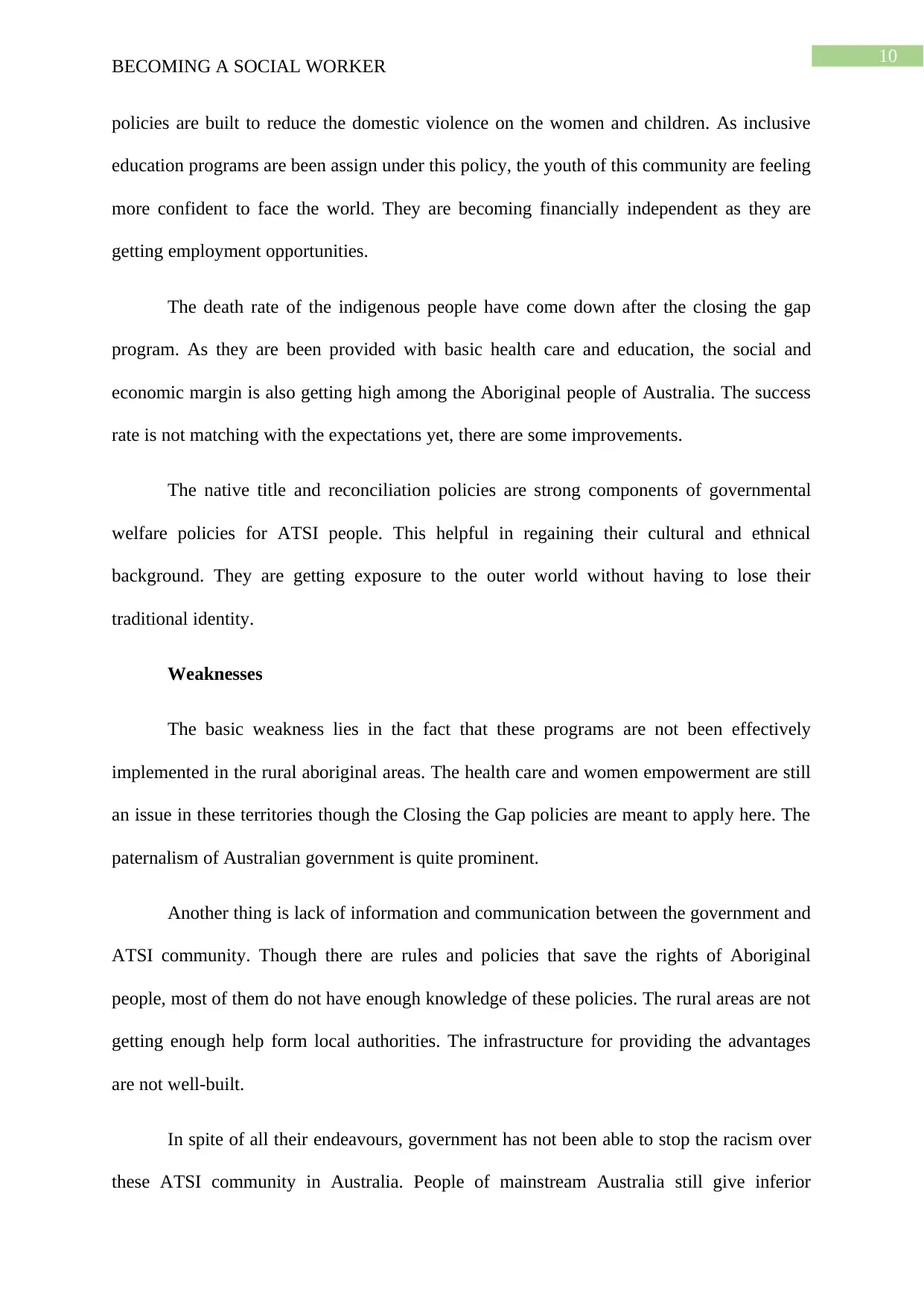
10
BECOMING A SOCIAL WORKER
policies are built to reduce the domestic violence on the women and children. As inclusive
education programs are been assign under this policy, the youth of this community are feeling
more confident to face the world. They are becoming financially independent as they are
getting employment opportunities.
The death rate of the indigenous people have come down after the closing the gap
program. As they are been provided with basic health care and education, the social and
economic margin is also getting high among the Aboriginal people of Australia. The success
rate is not matching with the expectations yet, there are some improvements.
The native title and reconciliation policies are strong components of governmental
welfare policies for ATSI people. This helpful in regaining their cultural and ethnical
background. They are getting exposure to the outer world without having to lose their
traditional identity.
Weaknesses
The basic weakness lies in the fact that these programs are not been effectively
implemented in the rural aboriginal areas. The health care and women empowerment are still
an issue in these territories though the Closing the Gap policies are meant to apply here. The
paternalism of Australian government is quite prominent.
Another thing is lack of information and communication between the government and
ATSI community. Though there are rules and policies that save the rights of Aboriginal
people, most of them do not have enough knowledge of these policies. The rural areas are not
getting enough help form local authorities. The infrastructure for providing the advantages
are not well-built.
In spite of all their endeavours, government has not been able to stop the racism over
these ATSI community in Australia. People of mainstream Australia still give inferior
BECOMING A SOCIAL WORKER
policies are built to reduce the domestic violence on the women and children. As inclusive
education programs are been assign under this policy, the youth of this community are feeling
more confident to face the world. They are becoming financially independent as they are
getting employment opportunities.
The death rate of the indigenous people have come down after the closing the gap
program. As they are been provided with basic health care and education, the social and
economic margin is also getting high among the Aboriginal people of Australia. The success
rate is not matching with the expectations yet, there are some improvements.
The native title and reconciliation policies are strong components of governmental
welfare policies for ATSI people. This helpful in regaining their cultural and ethnical
background. They are getting exposure to the outer world without having to lose their
traditional identity.
Weaknesses
The basic weakness lies in the fact that these programs are not been effectively
implemented in the rural aboriginal areas. The health care and women empowerment are still
an issue in these territories though the Closing the Gap policies are meant to apply here. The
paternalism of Australian government is quite prominent.
Another thing is lack of information and communication between the government and
ATSI community. Though there are rules and policies that save the rights of Aboriginal
people, most of them do not have enough knowledge of these policies. The rural areas are not
getting enough help form local authorities. The infrastructure for providing the advantages
are not well-built.
In spite of all their endeavours, government has not been able to stop the racism over
these ATSI community in Australia. People of mainstream Australia still give inferior
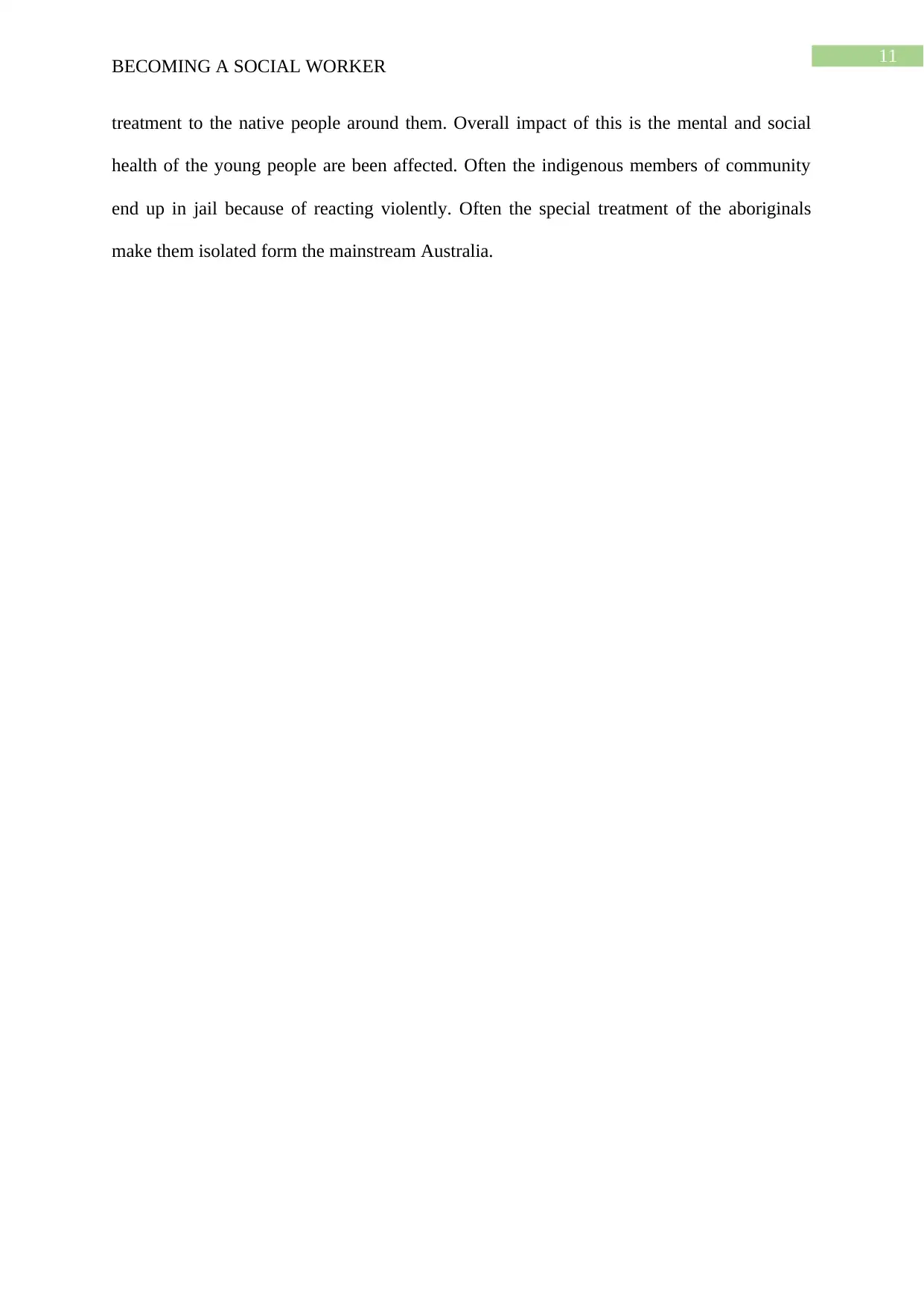
11
BECOMING A SOCIAL WORKER
treatment to the native people around them. Overall impact of this is the mental and social
health of the young people are been affected. Often the indigenous members of community
end up in jail because of reacting violently. Often the special treatment of the aboriginals
make them isolated form the mainstream Australia.
BECOMING A SOCIAL WORKER
treatment to the native people around them. Overall impact of this is the mental and social
health of the young people are been affected. Often the indigenous members of community
end up in jail because of reacting violently. Often the special treatment of the aboriginals
make them isolated form the mainstream Australia.
⊘ This is a preview!⊘
Do you want full access?
Subscribe today to unlock all pages.

Trusted by 1+ million students worldwide
1 out of 14
Related Documents
Your All-in-One AI-Powered Toolkit for Academic Success.
+13062052269
info@desklib.com
Available 24*7 on WhatsApp / Email
![[object Object]](/_next/static/media/star-bottom.7253800d.svg)
Unlock your academic potential
Copyright © 2020–2025 A2Z Services. All Rights Reserved. Developed and managed by ZUCOL.




